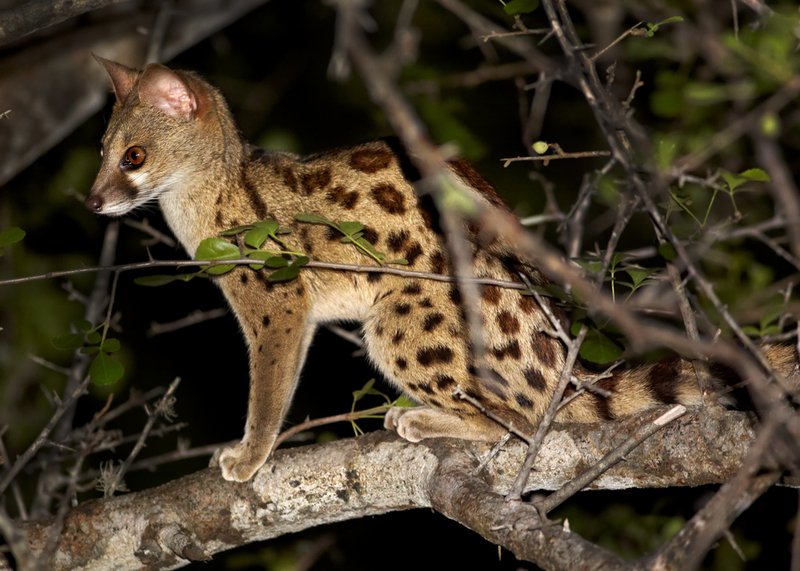
If you’ve never heard of a genet, you’re in for a treat! These remarkable creatures belong to the family Viverridae, which also includes civets and otter civets. Native to Africa, Europe, and parts of Asia, genets are often mistaken for small cats due to their slender bodies and long tails. Think of them as the wild cousins of the domestic feline. They’re agile, inquisitive, and have a playful nature that can captivate anyone who is lucky enough to spot one.
Genets have a striking appearance, with large, expressive eyes and spots or stripes on their fur, giving them a unique look. Their size typically ranges from 18 to 30 inches in length, not including their tail, which can be as long as their body. Imagine a little cat with an even longer tail—this is how a genet presents itself! Despite their resemblance to cats, genets are more closely related to mongooses and civets.
You might be wondering what makes genets so special beyond their appearance. For starters, they are incredibly agile and possess a remarkable ability to climb. Their retractable claws and flexible bodies allow them to navigate trees with ease, making them skilled hunters of birds and small mammals. If you’re interested in wildlife or just love learning about quirky animals, the genet is worth knowing about!
Genet Habitats and Distribution
Genets can be found in a variety of habitats, from savannas to forests. They prefer environments that provide plenty of hiding spots and vertical spaces, like trees and shrubs. You’ll commonly spot them in woodlands and grasslands, especially where there are sufficient insects and small animals for them to hunt.
Their range extends across Africa, primarily in the sub-Saharan regions, but they also inhabit parts of Europe and the Arabian Peninsula. Some species, like the common genet, have adapted well to human settlements, making them more visible in urban areas. So, while you might think of them as exotic, there’s a chance a genet could be prowling around your neighborhood!
Interestingly enough, genets are nocturnal creatures, which means they’re most active at night. They hunt under the cover of darkness, using their keen sense of smell and excellent night vision to locate prey. This adaptiveness helps them thrive in various environments, from dense jungles to sparse savannas.
Diet of Genets
Genets are opportunistic eaters, meaning their diet can vary depending on what’s available in their habitat. They primarily feed on a mix of insects, small mammals, birds, and fruits. Imagine being a genet on a warm summer night: you’d be out and about, sniffing the air for a tasty treat or even a small rodent scuttling across the ground!
Insects make up a significant portion of their diet, especially during warmer months when they are plentiful. Genets are known for their agility and stealth, which allows them to sneak up on their prey. They use their keen senses to track movement and can make quick, precise leaps to catch dinner. Isn’t that fascinating?
You might also find it curious that genets are not above scavenging. If they come across a dead animal or leftover food, they won’t hesitate to munch on it. This adaptability in their diet not only helps them survive but also allows them to thrive in various environments.
Genet Behavior and Social Structure
When it comes to behavior, genets are known for their playful and curious nature. They are generally solitary, preferring to roam and hunt alone rather than in groups. However, during mating season, you might see males and females come together. Their social interactions are mostly limited to these mating periods, which keeps their lifestyle low-key and mysterious.
Genets communicate through a series of vocalizations, body language, and scent markings. While they might not speak human languages, their body movements can say a lot! You’ll notice them arching their backs or fluffing up their fur when they feel threatened. And when they’re feeling sociable, they may even vocalize with chirps or growls. Watching these interactions can be both entertaining and enlightening.
You might be curious about how they mark their territory. Genets use scent glands located on their bodies to leave their mark. They’ll often scratch trees or bushes to enhance their scent, letting other genets know they’ve been there. It’s like their own little billboard advertising their presence!
Genet Reproduction
Breeding season for genets typically occurs in spring and summer. After a gestation period of about 70 to 78 days, a female gives birth to a litter of 2 to 4 kits. These little ones are born blind and rely on their mother for care. She’s a dedicated mom, often moving her kits to a new den to keep them safe from predators.
As they grow, the kits begin to explore their surroundings, learning essential skills like climbing and hunting. By the time they’re around 3 to 4 months old, they start joining their mother on hunts. It’s heartwarming to think of a mother genet teaching her offspring the ropes of survival in the wild!
After about a year, juveniles will leave their mother to establish their territories. This independence is vital for their survival, as it helps prevent inbreeding and promotes genetic diversity. It’s a tough world out there, but these little ones are well-equipped to handle it!
Interesting Facts About Genets
| Size: | 18–30 inches long (not including tail) |
| Weight: | 3–7 pounds |
| Life Span: | Up to 12 years in the wild |
| Speed: | Can run swiftly, with agility to match! |
| Diet: | Insects, small mammals, and fruits |
| Habitat: | Forests, savannas, and human settlements |
Conservation Status
The conservation status of genets varies by species. While many are not currently threatened, habitat loss and hunting pose risks to certain populations. As urban areas expand into natural habitats, genets find themselves squeezed for space. You might not think of them as endangered animals, but the changes in their environment can have a significant impact.
Some species, like the common genet, are more adaptable and can thrive in modified habitats. However, others that live in specific ecosystems may be at greater risk. This is where conservation efforts become crucial. Preserving their natural habitats ensures future generations can enjoy the company of these charming creatures.
Many organizations are working diligently to study genets and protect their environments. By raising awareness and encouraging sustainable practices, we can help keep genets safe and thriving in the wild. It’s exciting to think that our actions can make a difference in the lives of these fascinating animals!
Genets as Pets
While genets are captivating creatures, they aren’t commonly kept as pets. They have specific needs that can be challenging to meet in a home environment. Their playful and energetic nature requires plenty of space to roam and climb. Additionally, they have unique dietary needs and may not thrive on standard pet food.
Moreover, genets are still wild animals at heart. They can be skittish and may not enjoy being handled like typical domestic pets. A better approach might be to appreciate them in their natural environment or in wildlife sanctuaries where their needs can be properly addressed.
If you’re considering a pet that resembles a genet, there are exotic breeds of cats that might offer a similar appearance without the wild instincts. Always do thorough research before bringing any new animal into your home. It’s essential to ensure that you can provide the right care for the animal’s well-being.
FAQ
What is the scientific name of the common genet?
The scientific name of the common genet is Genetta genetta. This species is one of the most widely recognized genets, known for its beautiful spotted coat and adaptability to various habitats.
Are genets nocturnal?
Yes, genets are primarily nocturnal. They spend their nights hunting and exploring, which helps them avoid larger predators that are more active during the day. Their nighttime activities make them fascinating to observe in the wild!
Do genets make sounds?
Absolutely! Genets communicate through a range of vocalizations, including chirps, growls, and hisses. These sounds can express their feelings, whether they’re feeling threatened or excited. It’s quite entertaining to listen to their vocal expressions!
How long do genets live in the wild?
In the wild, genets can live up to around 12 years, though this can vary based on factors like predation and habitat conditions. In captivity, with proper care, they might live even longer. Their lifespan is greatly influenced by their environment and access to resources.
What do genets eat in the wild?
In the wild, genets primarily eat insects, small mammals, birds, and fruits. Their opportunistic feeding strategy allows them to adapt their diet based on what’s available in their surroundings, making them clever hunters.
Aren’t genets similar to domestic cats?
While they might look like small cats, genets belong to a different family called Viverridae. Their behavior, diet, and habitat preferences set them apart from domestic cats, even though there are some similarities in appearance.
Can genets be found in urban areas?
Yes, some species of genets have adapted to urban environments. They are often seen in gardens or parks, especially if those areas provide safe hiding spots and food sources. This adaptability is a testament to their resilience.
What are the predators of genets?
In the wild, genets face threats from larger predators such as birds of prey, snakes, and larger carnivores. Their agility and climbing skills help them escape many of these dangers, but they must always remain cautious.
Is the common genet endangered?
Currently, the common genet is not considered endangered, but habitat loss and hunting do pose threats. Conservation efforts are important to ensure their populations remain stable and healthy.
How do genets mark their territory?
Genets mark their territory primarily through scent marking. They have glands located on their bodies that release scents, and they often scratch trees or bushes to enhance their mark. This behavior communicates to other genets that they’re in the area.
Are genets known to be friendly?
Genets can exhibit friendly behavior towards other genets, especially during mating season. However, they are generally solitary animals and can be skittish around humans. Their wild instincts make them less likely to bond in the same way domesticated animals do.

